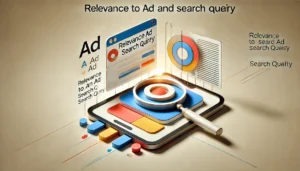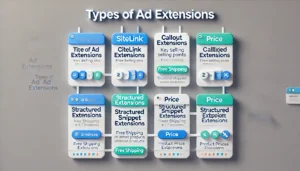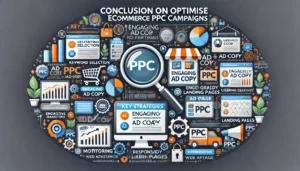How To Optimise eCommerce PPC Campaigns for UK Brands

In the fast-paced world of online shopping, optimising your eCommerce PPC campaigns is essential for UK brands looking to stand out. This guide will break down the key components of effective PPC strategies, helping you attract more customers and boost sales. From understanding the basics to advanced techniques, we’ll cover everything you need to know to make your PPC efforts successful.
Key Takeaways on How To Optimise YOUR eCom PPC Campaigns
- PPC advertising is a cost-effective way to reach potential customers actively searching for products.
- Choosing the right keywords is crucial; focus on both broad and specific terms to capture diverse audiences.
- Creating engaging ad copy and visuals can significantly improve click-through rates and conversions.
- Regularly monitor and adjust your campaigns based on performance metrics to enhance effectiveness.
- Utilising ad extensions can provide additional information and increase the visibility of your ads.
Understanding the Basics of eCommerce PPC Campaigns
What is PPC Advertising?
Pay-per-click (PPC) advertising is a method where we pay a fee each time someone clicks on our ad. This means we’re buying visits to our site rather than trying to earn them organically. For eCommerce, this is especially useful. It allows us to reach potential customers actively searching for products like ours.
Why PPC is Crucial for eCommerce
PPC is vital for eCommerce brands for several reasons:
- Direct product promotion: We can showcase specific products directly in search results.
- Competitive edge: It helps us stand out in a crowded online marketplace.
- Remarketing opportunities: We can target users who have previously visited our site.
- Data-driven decisions: PPC provides insights into customer behaviour, allowing us to refine our strategies.
- Scalability: As our business grows, we can easily scale our PPC efforts.
Different Types of PPC Ads
There are various types of PPC ads we can use:
- Search ads: Text-based ads that appear in search engine results.
- Shopping ads: Product-specific ads that include images and prices.
- Display ads: Visual ads that appear on websites.
- Remarketing ads: Targeted ads for users who have interacted with our site.
- Video ads: Ads that appear before or during videos on platforms like YouTube.
In summary, understanding PPC is essential for any eCommerce brand looking to drive traffic and increase sales. By leveraging the right strategies, we can effectively reach our target audience and achieve our business goals.
Conducting Effective Keyword Research
Importance of Keyword Selection
When we think about PPC campaigns, keywords are at the heart of our strategy. They help us connect with potential customers searching for our products. Choosing the right keywords can significantly impact our ad performance. We should focus on both broad and specific keywords to reach a wider audience. Here are some key points to consider:
- Understand our target audience’s language.
- Use tools to find high-performing keywords.
- Regularly update our keyword list based on performance.
Tools for Keyword Research
There are several tools available that can assist us in finding the best keywords for our campaigns. Some popular options include:
- Google Keyword Planner
- SEMrush
- Ahrefs
These tools provide insights into search volume, competition, and related keywords, helping us make informed decisions.
Long-Tail vs Short-Tail Keywords
In our keyword strategy, we should consider both long-tail and short-tail keywords. Long-tail keywords are more specific and often have lower competition, making them easier to rank for. Short-tail keywords, while more competitive, can drive higher traffic. Here’s a quick comparison:
| Type of Keyword | Characteristics | Pros | Cons |
|---|---|---|---|
| Long-Tail | Specific phrases, 3+ words | Lower competition, higher conversion rates | Lower search volume |
| Short-Tail | General terms, 1-2 words | Higher search volume | More competition |
In summary, a balanced approach using both long-tail and short-tail keywords can enhance our PPC campaigns, ensuring we reach the right audience effectively.
Creating Compelling Ad Copy and Creatives
Elements of Effective Ad Copy
Creating effective ad copy is essential for capturing attention. How To Optimise eCommerce PPC Campaigns: We should focus on a few key elements:
- Clear Call-to-Action (CTA): Encourage users to take action, like “Shop Now” or “Learn More”.
- Unique Selling Proposition (USP): Highlight what makes our product special.
- Urgency: Phrases like “Limited Time Offer” can prompt quicker decisions.
Designing Eye-Catching Creatives
Visuals play a crucial role in our ads. Here are some tips:
- Use high-quality images that represent our products well.
- Keep the design simple and uncluttered.
- Ensure our brand colours and logos are prominent.
Using Urgency and Scarcity in Ads
Incorporating urgency and scarcity can significantly boost conversions. We can achieve this by:
- Mentioning limited stock availability.
- Offering time-sensitive discounts.
- Highlighting exclusive deals for a short period.
Remember, the goal is to create a seamless experience that leads potential customers from our ads to making a purchase. By focusing on compelling copy and attractive creatives, we can enhance our PPC campaigns effectively.
Setting Up Your PPC Campaign
Choosing the Right PPC Platform
When we start our PPC journey, the first step is to select the right platform. There are several options available, such as Google Ads, Facebook Ads, and TikTok Ads. We should consider where our target audience spends their time. Choosing the right platform can significantly impact our campaign’s success.
Setting a Realistic Budget
Next, we need to set a budget that aligns with our goals. It’s essential to think about:
- The cost of keywords
- Ad placements on our chosen platform
- Our overall advertising objectives
By doing this, we can ensure that we are not overspending while still achieving our desired outcomes.
Launching and Monitoring Your Campaign
Once everything is in place, we can launch our campaign. However, the work doesn’t stop there. We must monitor its performance regularly. This helps us to:
- Identify what’s working and what isn’t
- Make necessary adjustments
- Optimise our spending for better results
Setting up a PPC campaign is just the beginning. Continuous monitoring and adjustments are key to maximising our return on investment.
By following these steps, we can create a solid foundation for our PPC management efforts.
Optimising Landing Pages for Conversions
Relevance to Ad and Search Query
To ensure our landing pages convert effectively, they must be directly relevant to the ads and search queries that lead users there. A clear connection between the ad and the landing page can significantly boost conversion rates. We should focus on aligning the content, visuals, and messaging to meet user expectations.
Mobile-Friendly Design
In today’s world, many users shop on their mobile devices. Therefore, it’s crucial that our landing pages are mobile-friendly. This means they should load quickly and be easy to navigate on smaller screens. Here are some key points to consider:
- Use responsive design to adapt to different screen sizes.
- Ensure buttons and links are easily clickable.
- Minimise text input fields to enhance user experience.
Clear Call-to-Actions
A strong call-to-action (CTA) guides users on what to do next. It should be prominent and persuasive. For example, phrases like “Buy Now” or “Get Your Discount” can encourage immediate action. We can also use contrasting colours to make the CTA stand out.
A well-optimised landing page can turn visitors into customers, making it a vital part of our PPC strategy.
By focusing on these elements, we can create landing pages that not only attract visitors but also convert them into loyal customers.
Utilising Advanced Targeting Options
Demographic Targeting
In our PPC campaigns, we can reach specific groups of people based on their demographics. This includes age, gender, and location. By focusing on these factors, we can ensure our ads are seen by those most likely to be interested in our products. This targeted approach helps us save money and improve our conversion rates.
Interest and Behaviour Targeting
We can also target users based on their interests and online behaviour. This means we can show our ads to people who have previously shown interest in similar products. For example, if someone has been searching for home decor, we can present them with our latest furniture collection. Here are some key points to consider:
- Identify user interests through their online activity.
- Create tailored ads that resonate with these interests.
- Monitor engagement to refine our targeting further.
Remarketing Strategies
Remarketing allows us to reconnect with users who have previously visited our site but didn’t make a purchase. By showing them ads as they browse other sites, we can remind them of what they’re missing. This strategy can significantly boost our chances of conversion.
By utilising advanced targeting options, we can create highly personalised campaigns that resonate with our audience, ultimately leading to better results.
Implementing Effective Bidding Strategies
Manual vs Automated Bidding
When we think about bidding strategies, we have two main options: manual and automated bidding. Manual bidding allows us to set the maximum amount we’re willing to pay for each click. This gives us more control, especially if we’re just starting out. On the other hand, automated bidding uses smart algorithms to adjust our bids in real-time, helping us to maximise our results without constant monitoring.
Target ROAS and CPA
Understanding our goals is crucial. We can focus on two key strategies:
- Target ROAS (Return on Ad Spend): This helps us set a specific return we want from our ads.
- Target CPA (Cost Per Acquisition): This focuses on how much we’re willing to spend to acquire a customer.
Both strategies can help us achieve our desired outcomes, but we need to choose based on our business objectives.
Using Bid Adjustments
Bid adjustments allow us to fine-tune our campaigns. We can increase or decrease bids based on various factors:
- Device: Adjust bids for mobile or desktop users.
- Location: Increase bids for areas where we see better performance.
- Time of Day: Boost bids during peak shopping hours.
By using these adjustments, we can optimise our spending and improve our campaign performance.
In the world of PPC, the right bidding strategy can make all the difference. By understanding our options and continuously refining our approach, we can drive better results for our eCommerce campaigns.
Leveraging Ad Extensions for Better Visibility
Types of Ad Extensions
Ad extensions are a powerful tool in our PPC arsenal. They enhance our ads by providing additional information, making them more appealing to potential customers. Here are some common types:
- Sitelink Extensions: Direct users to specific pages on our website.
- Callout Extensions: Highlight unique selling points, like free shipping or 24/7 customer service.
- Structured Snippet Extensions: Showcase specific aspects of our products or services.
- Price Extensions: Display prices for our products directly in the ad.
Benefits of Using Ad Extensions
Utilising ad extensions can significantly improve our ad performance. They increase visibility and click-through rates, which can lead to higher conversions. Here are some benefits:
- Enhanced Visibility: Ads with extensions take up more space on the search results page.
- Improved Click-Through Rates: More information can lead to more clicks.
- Better User Experience: Customers find it easier to navigate to what they want.
Best Practises for Ad Extensions
To make the most of ad extensions, we should follow these best practises:
- Ensure all extensions are relevant to the ad content.
- Regularly update extensions to reflect current promotions or offerings.
- Monitor performance and adjust based on what works best.
By leveraging ad extensions effectively, we can enhance our PPC campaigns and drive more traffic to our eCommerce site.
Measuring and Analysing Campaign Performance
To truly understand how our PPC campaigns are performing, we need to focus on key metrics. Measuring success is not just about clicks; it’s about conversions. Here are some essential metrics we should track:
Key Metrics to Track
- Click-Through Rate (CTR): This shows the percentage of users who clicked on our ad after seeing it.
- Conversion Rate: This indicates how many users completed a desired action, like making a purchase, after clicking on our ad.
- Cost Per Conversion: This tells us how much we spend on average to acquire a conversion.
- Return on Ad Spend (ROAS): This metric reveals the revenue generated for every pound spent on advertising.
- Quality Score: Google rates the quality and relevance of our keywords and ads, which can affect our ad placements.
Using Analytics Tools
To make sense of these metrics, we can use various analytics tools. These tools help us gather data and provide insights into our campaigns. For instance, a Google ads audit can highlight areas for improvement.
Regular Campaign Audits
Conducting regular audits is crucial. Here’s why:
- Identify Weaknesses: We can spot underperforming ads or keywords.
- Adjust Strategies: We can refine our approach based on data.
- Maximise ROI: By focusing on what works, we can improve our return on investment.
Regularly analysing our PPC campaigns allows us to adapt and thrive in a competitive market.
In conclusion, measuring and analysing our campaign performance is vital for success. By focusing on the right metrics and using the right tools, we can ensure our PPC efforts are effective and profitable.
Common Challenges and How to Overcome Them
In the world of eCommerce PPC, we often face several hurdles that can impact our campaigns. Understanding these challenges is the first step towards overcoming them.
Dealing with High Competition
High competition in the eCommerce space can lead to increased costs per click. To tackle this:
- Focus on niche keywords that are less competitive.
- Use negative keywords to philtre out irrelevant traffic.
- Regularly review and adjust your bids to stay competitive.
Ad Fatigue and Creative Refreshes
Over time, our audience may become tired of seeing the same ads. This can lead to lower engagement rates. To combat ad fatigue:
- Rotate your ad creatives frequently.
- Test different headlines and images to see what resonates.
- Monitor performance metrics to identify when refreshes are needed.
Managing Seasonal Fluctuations
Seasonal changes can significantly affect product demand. To manage this:
- Prepare in advance for peak seasons by adjusting budgets and bids.
- Use historical data to predict trends and adjust campaigns accordingly.
- Consider seasonal promotions to attract customers during high-demand periods.
By recognising these challenges and implementing effective strategies, we can enhance our PPC campaigns and drive better results.
In summary, while challenges in eCommerce PPC are common, they can be effectively managed with the right approach. Let’s stay proactive and adaptable!
Scaling Your PPC Campaigns for Growth: How To Optimise eCommerce PPC Campaigns
When to Scale Your Campaigns
How To Optimise eCommerce PPC Campaigns: Scaling our PPC campaigns is a crucial step in maximising our online presence. We should consider scaling when we notice consistent performance metrics, such as a steady increase in conversions and a positive return on ad spend (ROAS). If our campaigns are performing well, it’s time to invest more.
Strategies for Scaling
To effectively scale our campaigns, we can follow these strategies:
- Increase Budget Gradually: Instead of making drastic changes, we should increase our budget in small increments to monitor performance.
- Expand Keyword Targeting: Adding new keywords can help us reach a broader audience. We can explore related terms and long-tail keywords.
- Test New Ad Formats: Trying different ad formats, such as video or shopping ads, can attract more attention and engagement.
Monitoring Scaled Campaigns
Once we scale our campaigns, it’s essential to keep a close eye on their performance. We should regularly check key metrics like:
- Click-through rate (CTR)
- Conversion rate
- Cost per acquisition (CPA)
Scaling our PPC campaigns is not just about spending more; it’s about making informed decisions based on data. By continuously analysing our results, we can ensure that our growth is sustainable and effective.
If you want to grow your PPC campaigns, it’s time to take action! Visit our website today for a free review of your ads. Let us help you achieve better results and reach your goals!
Conclusion on How To Optimise eCommerce PPC Campaigns
In summary, optimising your eCommerce PPC campaigns is essential for UK brands looking to enhance their online presence and boost sales. By focusing on key strategies such as selecting the right keywords, crafting engaging ad copy, and ensuring your landing pages are user-friendly, you can significantly improve your campaign’s performance. Regular monitoring and adjustments based on data insights will help you stay ahead of the competition. If you find the process overwhelming, consider seeking assistance from PPC specialists who can guide you through the complexities of digital advertising. With the right approach, your eCommerce business can thrive in the competitive online marketplace.
How To Optimise eCommerce PPC Campaigns: Frequently Asked Questions
What is PPC advertising and how does it work?
PPC, or pay-per-click advertising, is a way to promote your products online. You pay a fee each time someone clicks on your ad. This helps bring visitors to your website more quickly than waiting for them to find you organically.
Why is PPC important for eCommerce businesses?
PPC is vital for eCommerce as it helps to attract customers who are already looking to buy. It allows businesses to appear in search results when potential buyers are searching for specific products.
How can I choose the right keywords for my PPC campaign?
Selecting the right keywords is crucial. Think about what words customers might use to find your products. Tools like Google Keyword Planner can help you find popular keywords.
What should I include in my ad copy?
Your ad copy should be clear and engaging. Include a strong call-to-action, highlight unique features of your product, and mention any special offers to encourage clicks.
How can I improve my landing pages for better conversions?
Make sure your landing pages match what your ad promises. They should load quickly, be easy to navigate, and have clear calls-to-action to guide users towards making a purchase.
What are ad extensions and why should I use them?
Ad extensions are extra pieces of information you can add to your ads, like phone numbers or additional links. They help your ad stand out and provide more information to potential customers.
How do I measure the success of my PPC campaigns?
You can measure success by looking at metrics like click-through rate (CTR), conversion rate, and return on ad spend (ROAS). These will help you understand how well your ads are performing.
What common challenges might I face with PPC advertising?
Some challenges include high competition for popular keywords, ad fatigue where users ignore your ads, and seasonal changes in demand that affect your campaigns.
Author
Search Blog
Free PPC Audit
Subscribe to our Newsletter
The Voices of Our Success: Your Words, Our Pride
Don't just take our word for it. With over 100+ five-star reviews, we let our work-and our satisfied clients-speak for us.
"We have been working with PPC Geeks for around 6 months and have found Mark and the team to be very impressive. Having worked with a few companies in this and similar sectors, I rate PPC Geeks as the strongest I have come across. They have taken time to understand our business, our market and competitors and supported us to devise a strategy to generate business. I value the expertise Mark and his team provide and trust them to make the best recommendations for the long-term."
~ Just Go, Alasdair Anderson





